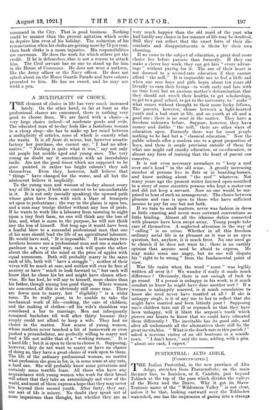T HE Italian Pusterthal, in the new province of Alto Adige,
stretches from Franzensfeste, on the main Brenner line, to Innichen, or S. Candido, just beyond Toblach at the top of the pass which divides the valleys of the Rienz and the Drave. Why it got its Slava. Teutonic name of the " Wilderness Valley " is not clear, unless it be that, looking eastward over the Toblacher watershed, one has the impression of gazing into a strange. no-man's-land, peopled by that fateful, indeterminate folk, the Slays i • and certainly the lateral valleys to the north —Ahrnthfd, Antholz, Gsiesers—are as wildernessy as one . could wish to see. The Pusterthal itself, however, with its bright and homely little villages—Niederdorf, Weisberg, -S. Lorenzen, Mahlbaoh—and its walled and castled capital of Bruneck, each full of running water, and their windows ablaze with flowers, is by no means a wilderness ; and for those in search of comparative quiet and moderate prices, these villages are places much to be commended. Most of the inns are old-fashioned, solidly built houses, belonging to the posting days, with excellent large bed- rooms. It is well to be prepared for a certain crudeness in the domestic arrangements. Some German is needful if you want friendly, smiling attention. Italian may serve at station or post office, but is not in free and willing use as yet. The prices are still quite moderate, though they tend to rise as Italian taxation comes into force. The food is abundant and excellent, of the Austrian type ; the wine, the sound red and white Tiroler of the Eppan and Terlan districts. I should say that anyone could live comfortably and copiously for twenty-five to thirty lire a day, and with exchange at its present rate that is moderate enough, compared with prices in the main valley of the Adige.
The decisive geographical feature of the Pusterthal is that it runs east and west, like the Valtelline. The sun fills it from morning till night ; the air is unusually dry, so dry that an hour after a thunderstorm you could hardly tell that rain had fallen. The valley is broad and open, and you get the relief of distant views to east and west, from the Lienzer Dolomites to some of the Oetzthaler Group. Another striking feature is the fact that the valley marks the division between two widely different geological formations. To the south, above the forests which clothe the nearer slopes, spring the needles and towers and buttresses of the Ampezzaner Dolomites- Dfirrenstein, Birkenkofle, Neuner, with Cristallo and Popena visible up the Holenstein Gorge from Toblach, and the Hohe Gaisl, or Croda Rossa, at the head of the Alt-Pragserthal ; while to the north lie the gentler curves and slopes of a limestone formation. This happy geological accident gives the Pusterthal villages a great variety of walks and of flora, though most of the flowers are gone before the first visitors arrive.
The river of the valley is the beautiful Rienz, a stream of exquisite pale aquamarine water, which owes its lim- pidity to the fact that it has been able to deposit its detritus in the lakes of Diirrensee and Toblachersee ; only after heavy rain are its waters muddied by the spates which come down the Wildbach from the desolate regions of the Pfannhorn.
Of all the places in the valley, Niederdorf perhaps comes first and highest in quality as in position. It is near the top of the pass ; you can look far in both directions.
The air is peculiarly light and dry, the water delicious. Moreover, it has been spared the ruin of war, which makes its neighbour Toblach an abomination of desolation which it will take years to cover decently. The walks are numerous, and the railway that serves the valley helps for the more distant. In the side valleys the two choice places are the quiet little inn on the Toblachersee, just where the babbling Rienz leaves the lake, and the pine forests slope down in feathery, silver silence to the green waters. The other is the famous Bad Altprags, in the Pragserthal, famous for over four hundred years now. A large house, with comfortable open and closed verandas, and the little Church of St. Theobald hard by, stand on the slope of a hill, facing south. Across a beautiful stretch of park-like lawn, set with fine trees, single and in clumps, you look to the great crags of the Durrenstein and the Hohe Gaisl, within easy reach for climbers, and through the park runs the post road that will take you on to quiet little Brackele and up to the glorious open pastures of the Platzwiese.



































 Previous page
Previous page